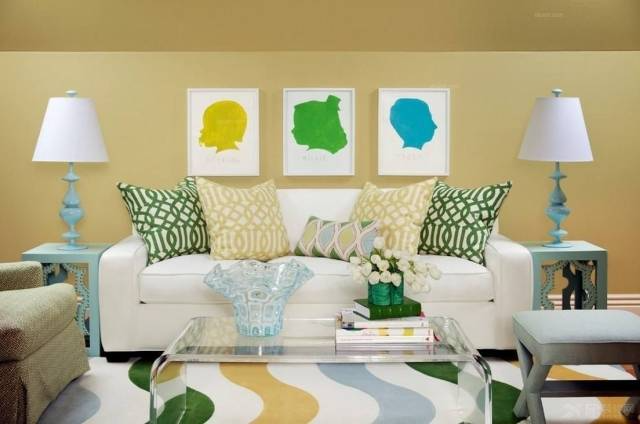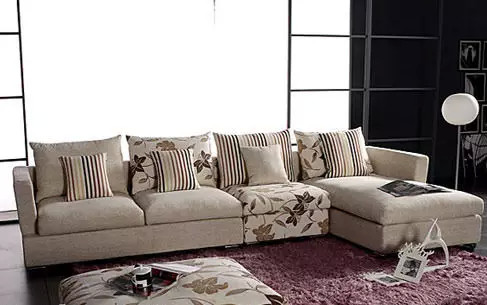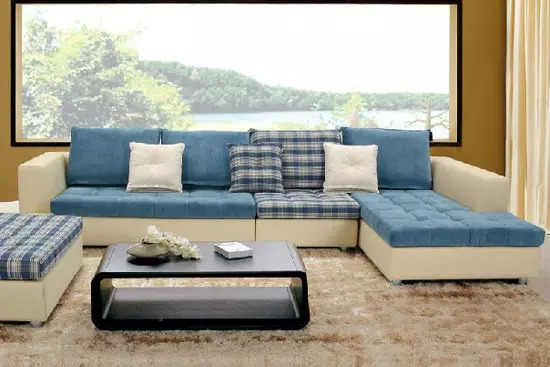【Furniture Knowledge】Things You Don’t Know About Fabric Sofas

1. Production process: Flocking uses the physical property of opposite charges attracting each other to make the fluff carry negative charge. The cloth to be flocked is placed under zero potential or grounding conditions. The fluff is attracted by the plant body with different potential and accelerates vertically to the surface of the object to be flocked. Since the plant body is coated with adhesive, the fluff is vertically adhered to the plant body.
2. Advantages: strong three-dimensional sense, bright colors, soft touch, good color fastness, friction resistance, smooth and gap-free.
3. Cleaning method: When cleaning, be careful not to soak it in water, rub or brush it. Just use cotton gauze dipped in alcohol or gasoline to gently wipe it. If the flannel is too wet, do not twist it hard to avoid the flannel falling off and affecting the appearance. The correct cleaning method should be to press the water with both hands or let it dry naturally, and brush the flannel in one direction to keep the original appearance of the flocking.

1. Production process: The characteristic of cut velvet is that the grey fabric is double-layered during weaving, and after weaving, it is cut in the middle to produce the middle velvet surface. Because the velvet is obtained by cutting, the velvet itself is not very strong, so there is a special glue brushing process in the post-finishing process to fix the velvet surface. The easiest way to check the quality of velvet is to gently rub the back of the velvet with your fingers. If the velvet does not fall off, it is of good quality.
2. Advantages: The velvet surface is uniform, the gloss is good, the velvet feels very comfortable, it is wear-resistant and easy to clean.
3. Cleaning method: Do not soak it in water, rub it or scrub it. Just wipe it gently with cotton gauze dipped in alcohol or gasoline. If the flannel is too wet, do not twist it hard to avoid the flannel falling off and affecting the appearance. The correct cleaning method should be to press the water with both hands or let it dry naturally. When scrubbing, it should be placed on a flat wooden board or table and scrubbed along the texture to keep the color uniform and avoid the fabric from getting fuzzy.
1. Production process: Printed fabrics can be divided into transfer printing, penetration printing, and reactive printing according to different processes. Home and sofas are basically made of reactive printing fabrics.
2. Advantages: bright colors, no pilling, no rough edges, and not easy to deform.
3. Cleaning method: It is best to wash with cold or warm water first. It is not suitable to soak or wash with boiling water, nor to pile it for too long.
1. Production process: The pattern of raised patterns woven on the fabric by warp and weft is called jacquard. Two-color or even multi-color jacquard fabric is woven with yarns of different colors.
2. Advantages: plump feel, thick texture, strong and wear-resistant, good air permeability, comfortable to sit on, not stuffy or damp. The pattern has layers, the color is unique, and the concave and convex have a three-dimensional sense.
3. Cleaning method: Jacquard fabrics should not be scrubbed vigorously with a hard brush to avoid fuzzing of the fabric surface.

1. Production process: cloth woven from cotton yarn
2. Advantages: good air permeability, soft touch, simple appearance with natural beauty, soft luster, and particularly good alkali and heat resistance.
3. Cleaning method: Before washing, soak it in water for a few minutes, but not too long to avoid damaging the color. It can be hand-washed or machine-washed, but because cotton fibers have poor elasticity, do not rub them hard during washing to avoid deformation and affecting the size. When the cloth cover is washed and drained, it should be folded up, and the water should be squeezed out in large handfuls or wrapped in a towel to squeeze out the water. Do not twist it hard or hang it up to drip dry. When drying in the sun, the reverse side should be facing outwards.
1. Production process: Cotton cloth contains linen components, also known as cotton and linen interwoven fabric, including ramie cotton and linen cotton.
2. Advantages: Good air permeability and sweat permeability. Cotton and linen can absorb sweat and micro-perspiration on human skin, so that body temperature quickly returns to normal, truly achieving the effect of air permeability and sweat absorption, warm in winter and cool in summer. It is comfortable to use close to the body, it stops itching, and is skin-friendly. The pH value is acidic, non-irritating to the skin, and meets the requirements of environmental protection and human health. Anti-static, no pilling, no curling, cotton and linen are sewn with pure cotton, without free charge, cotton fibers are not easy to deform and do not pill. Natural and environmentally friendly, it is a real green ecological textile. The use of cotton and linen can produce a warming effect on the human body, increase the microcirculation of the human body, effectively regulate the nervous system, dredge the meridians, and improve sleep quality.
3. Cleaning method: Linen fiber is rigid and has poor cohesion. When washing, it should be washed more gently than cotton fabric. Do not use a hard brush or rub it hard to avoid fluffing. Do not wring it hard after washing. Do not soak colored fabrics in hot water or expose them to the sun to avoid fading.
1. Manufacturing process: artificial high polymer,
2. Advantages: strong and durable, easy to care for, anti-wrinkle and non-ironing. Adding antibacterial agent makes it antibacterial; adding mineral micro powder makes it have low radiation function or far infrared radiation function.
3. Cleaning method: The temperature of the washing liquid should not exceed 45℃. Use a brush to clean the dirty parts. Rinse it after washing, wring it lightly, and dry it in a cool and ventilated place. Do not expose it to the sun or tumble dry it to avoid wrinkles caused by heat.
1. Production process: the fabric is made of animal suede. Now in the cloth market, suede has become a common name for various imitation leather suedes, including denim imitation leather suede, warp imitation leather suede (cloth-based imitation leather suede), weft imitation leather suede (satin imitation leather suede), warp knitted imitation leather suede, double-sided imitation leather suede, elastic imitation leather suede, etc.
2. Advantages: soft and sticky feel, good drape and light texture.
3. Cleaning method: First wipe off the dust on the surface with a dry cloth, then wipe the surface with a slightly damp soft cloth. Be careful not to use too much force. Straighten the hair on the suede in one direction to make the overall color of the cloth uniform.
Fabric sofas should be kept away from direct sunlight for a long time. For routine maintenance, you can pat them gently with a wrung towel and vacuum them regularly. It is best to vacuum them once a week. Pay attention to cleaning the armrests, backrests and gaps. Do not use a brush to avoid damaging the weave and making the fabric fluffy. For local contamination of fabric sofas, you can use a small amount of alcohol or water to clean them, and then wipe them with a towel. To avoid leaving marks, it is best to wipe from the outside of the stain. Velvet furniture should not be dipped in water, and dry cleaning agents should be used. Cloth covers and bushings should be dry cleaned as much as possible.